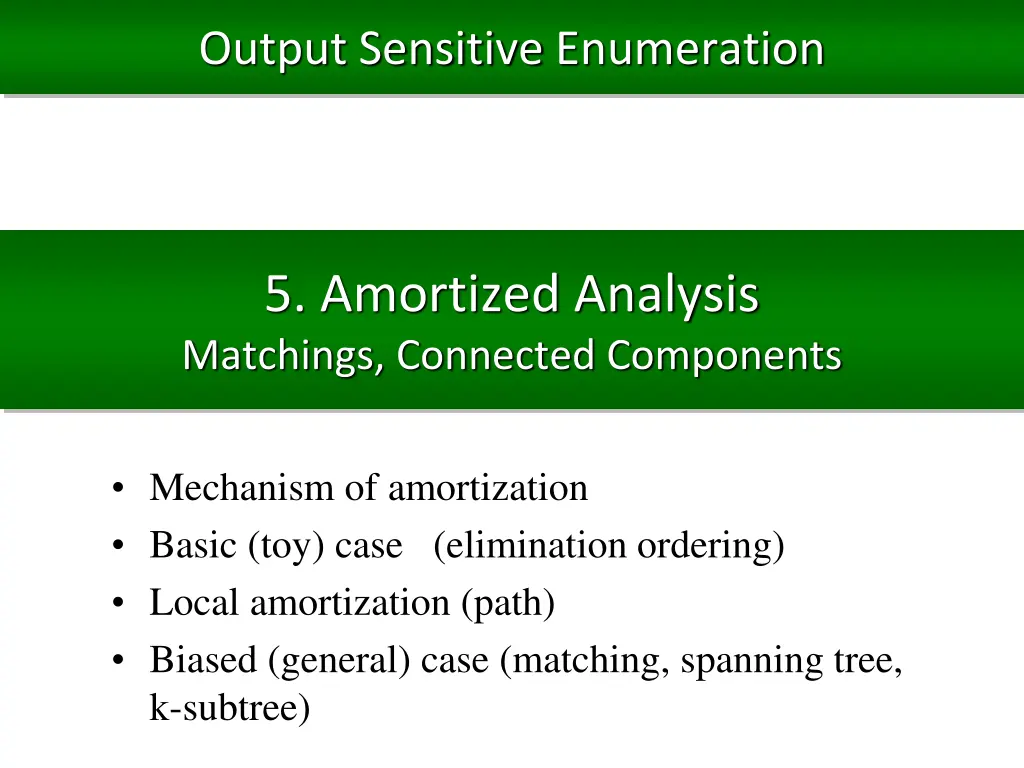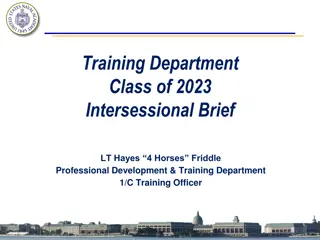
Output-Sensitive Enumeration and Amortized Analysis: Understanding Algorithm Time Complexity
Explore the concept of output-sensitive enumeration with amortized analysis to determine algorithm time complexity in combinatorial problems using tree-shaped recursion algorithms. Discover how the number of solutions impacts the efficiency of iteration and solution outputs through various scenarios.
Uploaded on | 0 Views
Download Presentation

Please find below an Image/Link to download the presentation.
The content on the website is provided AS IS for your information and personal use only. It may not be sold, licensed, or shared on other websites without obtaining consent from the author. If you encounter any issues during the download, it is possible that the publisher has removed the file from their server.
You are allowed to download the files provided on this website for personal or commercial use, subject to the condition that they are used lawfully. All files are the property of their respective owners.
The content on the website is provided AS IS for your information and personal use only. It may not be sold, licensed, or shared on other websites without obtaining consent from the author.
E N D
Presentation Transcript
Output Sensitive Enumeration 5. Amortized Analysis Matchings, Connected Components Mechanism of amortization Basic (toy) case (elimination ordering) Local amortization (path) Biased (general) case (matching, spanning tree, k-subtree)
There is an Algorithm Suppose that there is an enumeration algorithm A. we want to know time complexity of A (output polynomiality) What is needed? What will we obtain as a result? We assume that A is a tree-shaped recursion algorithm (the structure of the recursion is a tree) and the problem is combinatorial. (has at most 2n solutions)
Iteration = O(X) We now know that each iteration takes O(X) time. Can we do something? No. Possibility for exponentially many iterations, with few solutions ex) feasible solutions for SAT, with branch-and-bound algorithm O(X) O(X)
Solution for Each We now know that each iteration outputs a solution. Can we do something? Yes! #solutions =#iterations O(X) time for each solution O(X) O(X)
Solutions at Leaves We now know that at each leaf, a solution is output. Can we do something? ex) s-t paths, spanning trees, No. Possibility for exponentially many inner iterations, with few leaves O(X) EXP. many O(X)
Bounded Depth We now know that the height of recursion tree is at most H Can we do something? YES![#iterations]<[#solutions] O(X H) time for each solution [height] O(X) O(H) O(X)
At least Two Children Instead of the height, we now know that each non-leaf iteration has at least two children Can we do something? YES![#iterations]<2 O(X) time for each solution [#solutions] O(X) two two two
Good Three Cases These three cases are typical in which we can bound the time complexity efficiently In each case, the time complexity for an iteration depends on maximum computation time on an iteration If we want to do better, we have to use amortized analysis (average computation time of an iteration) two two two
Bottom-wideness An iteration of enumeration algorithm generates recursive calls for solving subproblems Subproblems are usually smaller than the original problem Many bottom level iterations take short time, few iterations take long time (we call bottom-wideness) Can we do something better? long middle middle short short short short
Bad Case An iteration of enumeration algorithm generates recursive calls for solving subproblems Subproblems are usually smaller than the original problem Many bottom level iterations take short time, few iterations take long time n Can we do something better? n-1 1 n-2 1 No. not sufficient in the right case, an iteration takes O(n) time on average 1 2 1 1
Balanced The recursion tree was biased. If balanced? No. not sufficient in the right case, an iteration takes O(n) time on average n n-1 n-1 n-2 n-2 1 1 1 1 1 What is sufficient to reduce the amortized time complexity?
Sudden Decrease n In the cases, sudden decrease occurs. time for parent and child differ much n-1 1 n-2 1 We shall clarify good characterization for no sudden decrease 1 2 1 1 Then, what is good? n n-1 n-1 n-2 n-2 1 1 1 1 1
Toy Case If any iteration has two children, and the computation time decreases constantly, the amortized computation time will be reduced computation time Ex) n + 2(n-1) + 4(n-2) + + 2n-1 2 + 2n 1 2 2n = O(1) #iterations n This holds for any polynomial n-1 n-1 n-2 n-2 { 2n-i poly(i) } / 2 2n= O(1) 1 1 1 1 1
Analysis This holds for any polynomial of the form poly(i) = i2, i3, { 2n-i poly(i) } / 2 2n= O(1) Compare the computation time on adjacent levels 2n-(i+1) poly(i+1) / 2n-i poly(i) = poly(i+1) / 2 poly(i) There are constants < 1 s.t. poly( i+1) / 2 poly( i ) < for any i > 0 n n-1 n-1 n-2 n-2 If bottom level iteration takes 1 unit time, total computation time < 2n ( 1 / (1- )) 1 1 1 1 1
Generalization of the Toy Case Assume that poly(i) is an arbitrary polynomial There are constant and < 1 s.t. poly(i+1) / 2 poly( i ) < for any i > When i < , poly(i) is constant, thus any iteration on level below takes constant time For i , { i 2n-i poly(i) } / 2 2n(n- )= O(1) n n-1 n-1 n-2 n-2 Therefore, amortized computation time for one iteration is O(1) 1 1 1 1 1
More Than Two Children Consider cases that an iteration may generate more than two recursive calls (so, iterations have three or more children) Let N(i) be the number of iterations in level i computation time on level i is bounded by N(i) poly(i) Compare adjacent levels N(i+1) poly(i+1) / N(i) poly(i) poly(i+1) / 2 poly(i) n n-1 n-2 Thus, in the same way, we can show amortized computation time for one iteration is O(1) 1 1 1 1 1
Application You may think this is too much trivial to enumeration algorithms However, surprisingly, there are applications n n-1 n-1 Consider the enumeration of elimination orderings n-2 n-2 1 1 1 1 1 Elimination ordering for given a structure (graph, set, etc.) a way of removing its elements one by one until the structure will be empty, with keeping a given property
Elimination Ordering for Connectivity unpublished Ex) For given a connected graph G=(V,E), remove vertices one by one with keeping the connectivity We can enumerate this elimination ordering by simple backtracking Each iteration takes O(|V|2) time Iter (G, X) 1.ifG is empty then outputX 2.for each vertex v in G, ifG-v is connected thencallIter (G-v, X+v)
Necessary Condition (1) For any connected graph, there are at least two vertices whose removals are connected Each (internal) iteration has at least two children (2) Computation time on an iteration in level i is O(i2) Amortized computation time of and iteration is O(1) time Iter (G, X) 1.ifG is empty then outputX 2.for each vertex v in G ifG-v is connected then callIter (G-v, X+v)
Small Pit Falls How to output X in O(1) time? output X by the difference from the previously output one Q Since the number of additions and deletions is linear in the number of iterations, the amortized output time is O(1) How to give G and X to the recursive call in O(1) time? always update them, and give them by pointers to G and X Q Before the recursive call, we remove v and adjacent edges from G, and add v to X After the recursive call, we add v and adjacent edges to G, and remove v from X. This doesn t increase the time/space complexity
Other Elimination Ordering There are many kinds of elimination orderings + perfect elimination ordering (chordal graphs) + strongly perfect elimination ordering (chordal graphs) + vertex on the surface of the convex hull (points) + edge coloring of bipartite graph can be also solved Ruskey et. al. 03 Ruskey et. al. 03 Matsui & U 05 At least, there proposed constant time algorithms for the first two (technical, to achieve amortized constant time for each iteration) We can have the same results with very very simple algorithms
Biased Recursion Trees The previous cases are something perfect + the height (depth) is equal at everywhere + computation time depends on the height n n-1 n/2 We want to have stronger tools that can be applied to biased cases n-2 n/4 1 1 1 1 1
Well-known Case Let T(x) be the computation time on iteration x If every child takes at most T(x) / , for some > 1 the height of the tree is O(log n) + useful in complexity analysis + however, #iterations is bounded by polynomial (not fit for enumeration) n n/3 n/2 n/6 n/4 We need another idea 1 1 1 1 1
Local Amortization If #children is large, amortized time complexity will be small even though sudden decrease occurs Let |Chd(x)| be #children of iteration x, and assign computation time T(x) to its children each child receives T(x) / |Chd(x)| 10 The time complexity of an iteration is O( max x { T(x) / ( |Chd(x)| + 1) } ) 2 2 We can use #grandchildren instead of #children 2 2 2 2 2
Estimating #(Grand)Children This analysis needs to estimate #children (and #grandchildren) this will be a technical part of the proof + estimate by the degree of the pivot vertex + #edges in a cycle + #edges in a cut
Enumeration of s?-path folklore Problem: given a graph G=(V,E), and a vertex s, enumerate all simple paths one of whose end is s Simply, by back tracking, we can solve Iter (G=(V,E), t, X) 1. outputX 2.for each vertex v in G adjacent to s callIter (G-t, v, X+v) s Each iteration takes O(d(t)) where d(t) is the degree of t the time complexity of an iteration is O(|V|)
Amortization + Each iteration takes O(d(t)) time + Each iteration generates d(t) recursive calls Thus, max x { T(x) / ( |Chd(x)| + 1) } = O(1), and the amortized time complexity of an iteration is O(1) s Iter (G=(V,E), s, X) 1.outputX 2. for each vertex v in G adjacent to s call Iter (G-s, v, X+v)
Other Problems By using #grandchildren, the complexity on the enumeration algorithms for the following structures are established + spanning trees of a given graph O(|V|) O(1) + trees of size k in a given graph O(|E|) O(k) etc
Computation time Increases In the toy cases, the key property was that the total computation time on each level increases with a constant factor, by going to a deeper level 2n-(i+1) poly(i+1) / 2n-i poly(i) = poly(i+1) / 2 poly(i) It seems that increase of computation time is good for us (it implicitly forbids sudden decrease ) Since the tree is biased, apply this idea locally --- parent and child (or descendants)
Local Increase In the toy cases, we compare the total computation time on a level and that on the neighboring level Instead of that, we compare the computation time of a parent, and the total time on its children the condition of the toy case is implemented as follows child Y of XT(Y) T(X) for some > 1 n We will characterize good cases by this condition n-1 n/2
PO Push Out Condition T* : the maximum computation time on a leaf T(X): computation time of iteration X S(X): computation time given to X by its parent C(X): set of child iterations of X > 1 constant PO Condition T(Y) Y C(X) T(X) T* (|C(X)|+1) ) S(X) = O( T(X) ) PO condition After the move, each iteration has O(T*) time
Formula Theorem: when PO condition holds, the amortized computation time of each iteration is bounded by O(T*) O(T*) time for each Proof: Assign O( ( /( +1))(|C(X)|+1)T*) of one s computation time to itself and its children ( fixed, never move again) Give the remaining to the children so that each child Z receives remaining { T(Z) / child Y of X T(Y) } (just move, for analysis) 9 6 3 Each child gives the given computation time and its own computation time to its children (so, grandchildren) recurs 4 8
Induction Each child gives the received computation time and its own computation time to its children (so, grandchildren) 9 (1+1/ ) / ( ) 9 Claim: under this rule, any iteration Z receives at most T(Z) / ( -1) from its parent ( T(Z)/ from parent, T(Z)/ 2from grandparent, ... ) 6 3 4 8 Suppose that an iteration X satisfies the condition Then, its child Z receives at most {T(Z) / Y C(X)T(Y)} {T(X)/ + T(X)- (( +1)/ )T*(|C(X)|+1)} = { T(Z) / Y C(X)T(Y) } { T(X) - T*(|C(X)|+1) } { T(Z) / } { / ( -1) } = T(Z) / ( -1) ( +1)/ PO condition
Example: Enumeration of Matchings Uno, 15 Problem: for given a graph G = (V, E), output all matchings of G matching: an edge subset s.t. no two edges are adjacent terms d(v): the degree of v G-e: the graph obtained from G by removing e G+(e): the graph obtained from G by removing edge e and edges adjacent to e G-u: the graph obtained from G by removing vertex u and edges incident to u
Basic Algorithm Iter (G=(V,E), M) 1. ifE = thenoutputM; return 2. choose an edge e of G 3. callIter (G-e, M) // enumerate those not including e 4. call Iter (G+(e), M e ) // enumerate those including e Clearly, correct An iteration takes O(|V|) time Leaf iterations output solutions Any iteration generates two recursive calls, thus #iterations / 2 #matchings Therefore, O(|V|) time for each matching
Observation An iteration takes O(d(u)+d(v)) time, in detail (where e=(u,v)) #edges in the input graph of children is at least |E|-1, |E| - d(u) - d(v), respectively Hereafter, for the sake of clear analysis, we estimate the computation time of an iteration by c ( |E| +1 ) = O(|E|) u v
Other Recursion For an iteration x, if an edge e=(u,v) satisfies d(u)+d(v) < |E| /2, childz of xT(z) 1.5 T(x) - O(T*) (2) is satisfied Otherwise, there is a vertex u s.t. d(u) |E| /4 We generate recursive calls for all edges incident to u u A. choose u s.t. d(u) |E| /4 B. for each e=(u,v), calliter (G+(e), M e) C. calliter (G-u, M) v In this case, |E| /4 recursive calls are generated, #children is at least |E| /4 (3) is satisfied
Overall Algorithm Iter (G=(V,E), M) 1. ifE = thenoutput M; return 2. if an edge e = (u,v) s.t. d(u)+d(v) < |E| /2 3. callIter (G-e, M) 4. callIter (G+(e), M e ) 5. else 6. choose u s.t. d(u) |E| /4 7. calliter (G-u, M) 8. for each e=(u,v), callIter (G+(e), M e) 9. end if u v
Case Analysis For an iteration x + if x is a leaf, then T(x) = O(T*) (1) is satisfied + otherwise, if an edge e=(u,v) satisfies d(u)+d(v) < |E| /2, childx of XT(z) 1.5 T(x) - O(T*) (2) is satisfied + otherwise, |E| /4 recursive calls are generated, #children is at least |E| /4 (3) is satisfied In any case, iteration x satisfies either (1), (2), or (3) amortized time complexity of iteration is O(T*) = O(1)
Spanning Trees A spanning tree is a tree including all vertices in the graph A spanning tree can be found in linear time by for example DFS, or BFS For given a graph, we consider the problem of enumerating all spanning trees in the graph
Dividing the Problem Consider a pivot edge e e spanning trees including edge e those in graph obtained by shrinking e spanning trees not including e those in graph obtained by removing e A simple binary partition takes O(|V||E|) time (|V|: size of a spanning tree (certificate), |E|: time to find a spanning tree)
Existing Best By adding a non-tree edge to generate a cycle, and remove a tree edge in the cycle, we can obtain another solution O(|V|) time for each Some algorithm reduces the time to O(1) time by using a data structure and bounding an iteration by O(children + grandchildren), by choosing a good pivot
Trick on Branching T*= O(1), but PO doesn t hold when e has many parallel/series edges e has parallel edges e1, , ek including one of e, e1, , ek, or including none e has series edges e1, , ek not including one of e, e1, , ek, or including all Graph for each is constructed in O(|E|) time PO condition holds when e has parallel/ series edges so that it has many children e






















